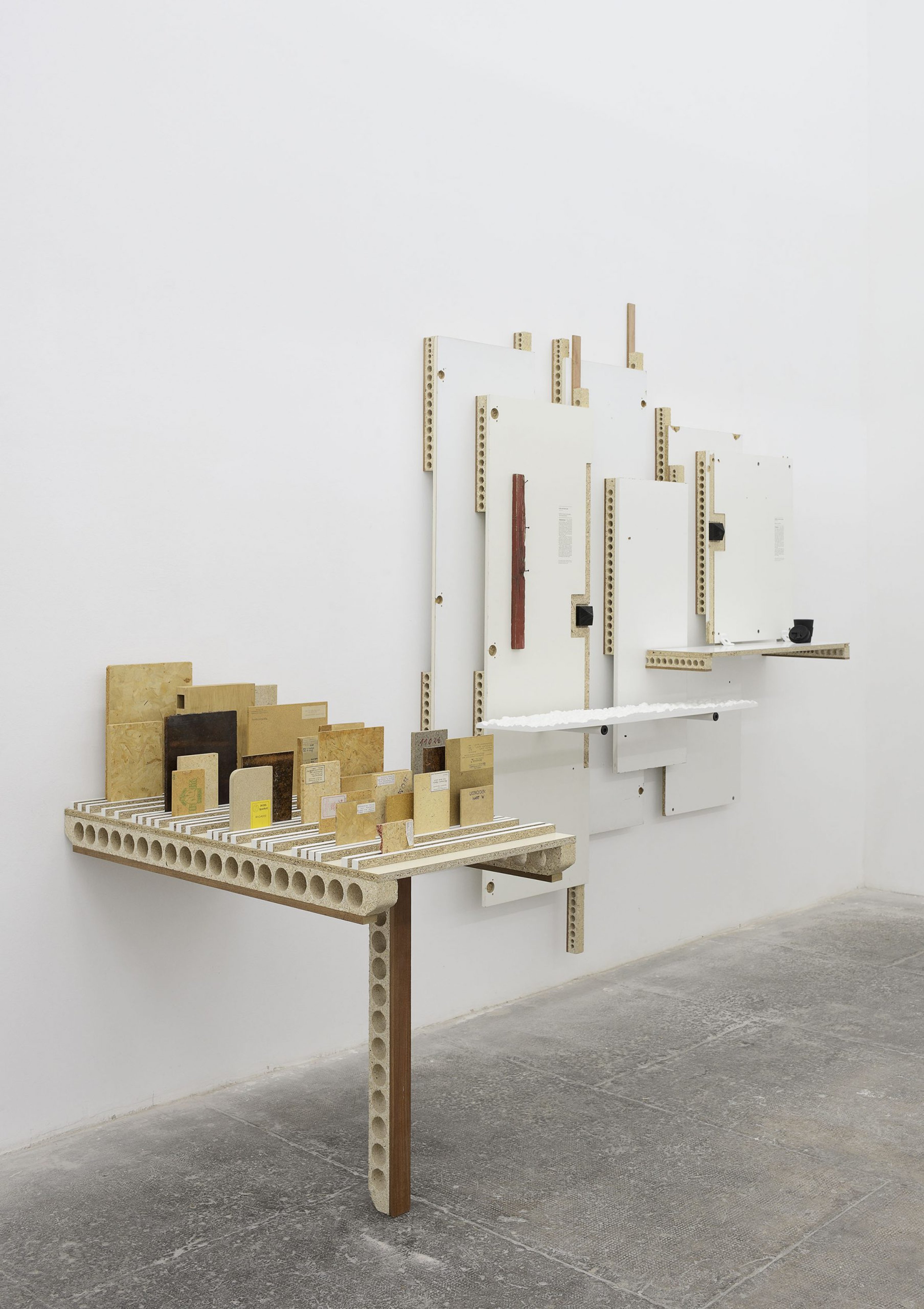
Collecteurs is pleased to present HELLO, a series of talks between curators and artists. In our first episode, curator Adam Carr, speaks with artist, James Beckett, who is currently in residency at ISCP New York.






Adam Carr (AC): This is the first of a series of online conversations between curators and artists and an interview series called: “Hello.” So hello, James.
James Beckett (JB): Hello Adam!
AC: You live and work in Amsterdam, but at the moment you’re in New York. So perhaps that’s a good place to start about the residency program that you’re currently on.
JB: Yeah. So I’m on the ISCP residency in New York City. I’ve been here since January and we’ve been in lockdown since March, mid-March, and things are starting to open up now. So it’s changing, but yeah, indeed the oddest of times, right? So it’s been very much like a bedroom experience as you can see behind me. So I exploit that wallpaper, because that’s a bit of the history of me being in this space. And now we’re just returning to studios, so yeah. That’s New York at the moment.
AC: Yeah. Also at the moment you have a solo exhibition at your gallery T293 at Rome called The Sceptical Structures of Max.
JB: Yes.
AC: So what really grabs me about this and your practice overall is that, for all of its kind of conceptual finesse, you seem to have a deep engagement with materials. And I just wondered what the pathway was for you coming across Max Himmelheber. What led you to this figure?
JB: So generally my research projects are quite a long trajectory. For this project, I had this urge to resolve Amsterdam in a way before I left for New York so I started looking at the layer of trash, which is this chipboard on the streets of Amsterdam. I had an inclination to research this, so it began from a very material, a very tangible starting point.
This quickly led me to the origin of this inventor, industrialist, entrepreneur in the neighborhood of Stuttgart, Germany – the Max Himmelheber Stiftung. This organisation has its own archive. So it became a very concrete biography within a very short time, which is always a nice window into an industrial history, you know?
AC: Yeah. So the chipboard was something that you found on the streets, was it not?
JB: Yeah. So I build installations and am always on the lookout for material. In seeing this layer of waste, in the sense of the Anthropocene, it struck me as such a prevailing thing that’s not much of a conversation, right? So people have this Ikea kind of reflex whereby they’re like, ‘Oh, what a shame’, you know like what happened to our traditional furniture that would pass generations and whatnot. So I approached chipboard from very much a social perspective – that this layer of trash is the result of a culture of linear production and consumption. What can be done with this conundrum? This quickly led me to the discovery that chipboard was initially an act of frugality, using waste from sawmills to produce a new material. Max Himmelheber was actually a sort of a pre-environmentalist. But the dirty secret of this material is that it’s bound with a glue called phenol resin, which is basically formaldehyde fixed in a stable state through heat and compression. So it’s this potentially poisonous layer that’s sitting all out on the streets.
image left: ‘The Sceptical Structures of Max’, 2019, courtesy T293
AC: Yeah. Do you feel like he had foreseen this problem and the invention and that’s why he subsequently—I don’t know if he escaped to Japan, but he became interested in Buddhism in later life.
JB: Yeah, so this is a little bit the chronological development for him – I mean, he took these patents from these experiments, from all these various plate materials, made standards and then oversaw the construction of factories around the world. This is what took him to various cities around Japan.
He was just taken back by the Japanese approach to life really. It was Shintoism that really caught his imagination because he had this environmental reflex as well. He was really beginning to develop an interest in efficiencies and consumption and how waste is so detrimental. He first experienced the Shintoist approach to nature when they were inaugurating a hydroelectric plant for one of their factories power delivery. On the opening of this hydroelectric plant a whole series of Shintoist monks recited prayers to apologize for the use of the water, to the water itself! Within Shintoism, you have this animist belief that spirits reside, within all kinds of objects and elements.
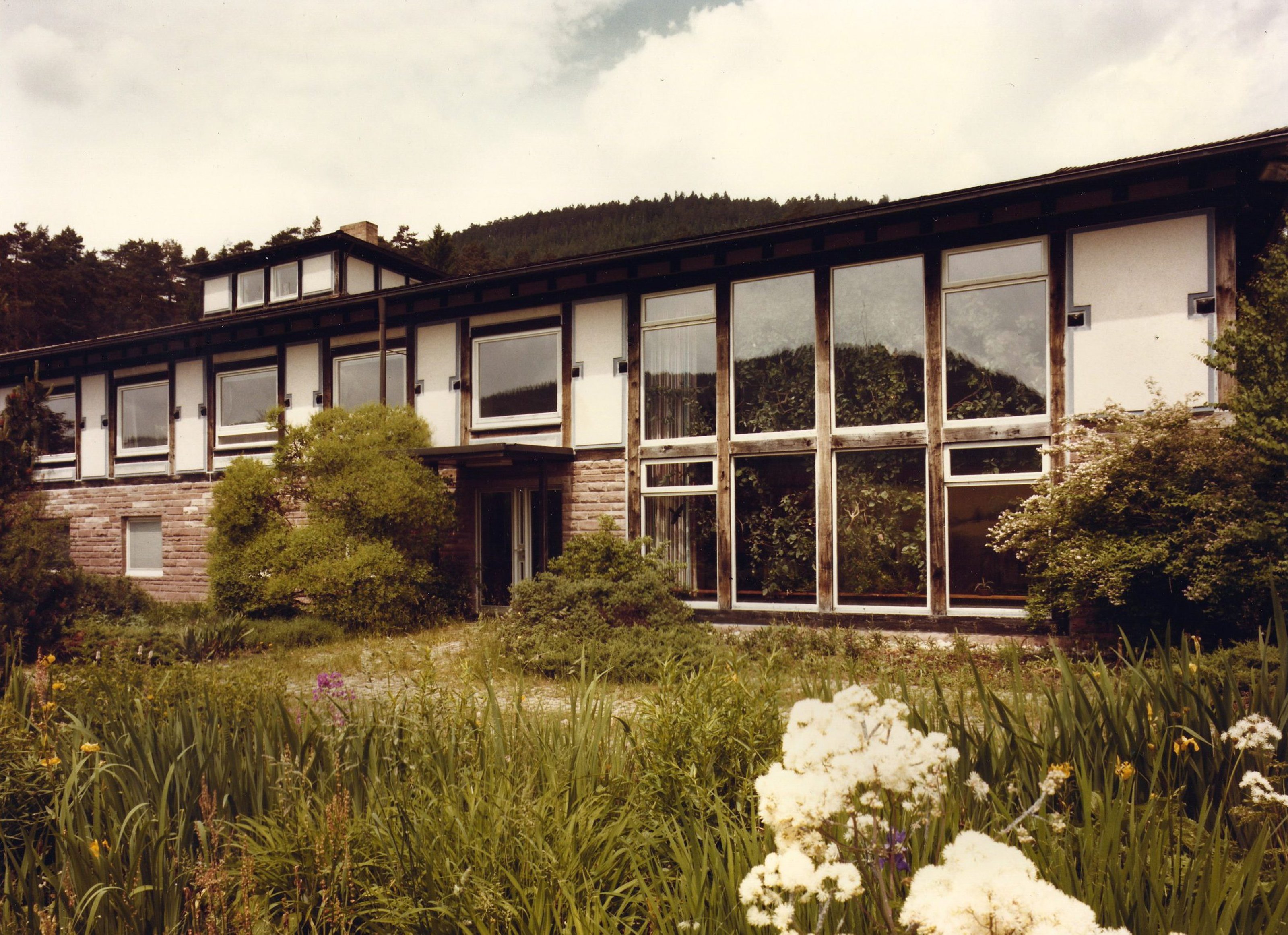
Villa Himmelheber, courtesy Die Max Himmelheber-Stiftung
He saw this sort of reckoning with nature as a very interesting, I guess, conceptual paradigm. He then embraced the approach and took this back to Germany. So he didn’t actually live in Japan for an extended period, but he imported certain aesthetics and elements of this belief system to the Schwartzwald of Germany.
AC: Yeah. And then he lived off the patents, no?
JB: Yeah.
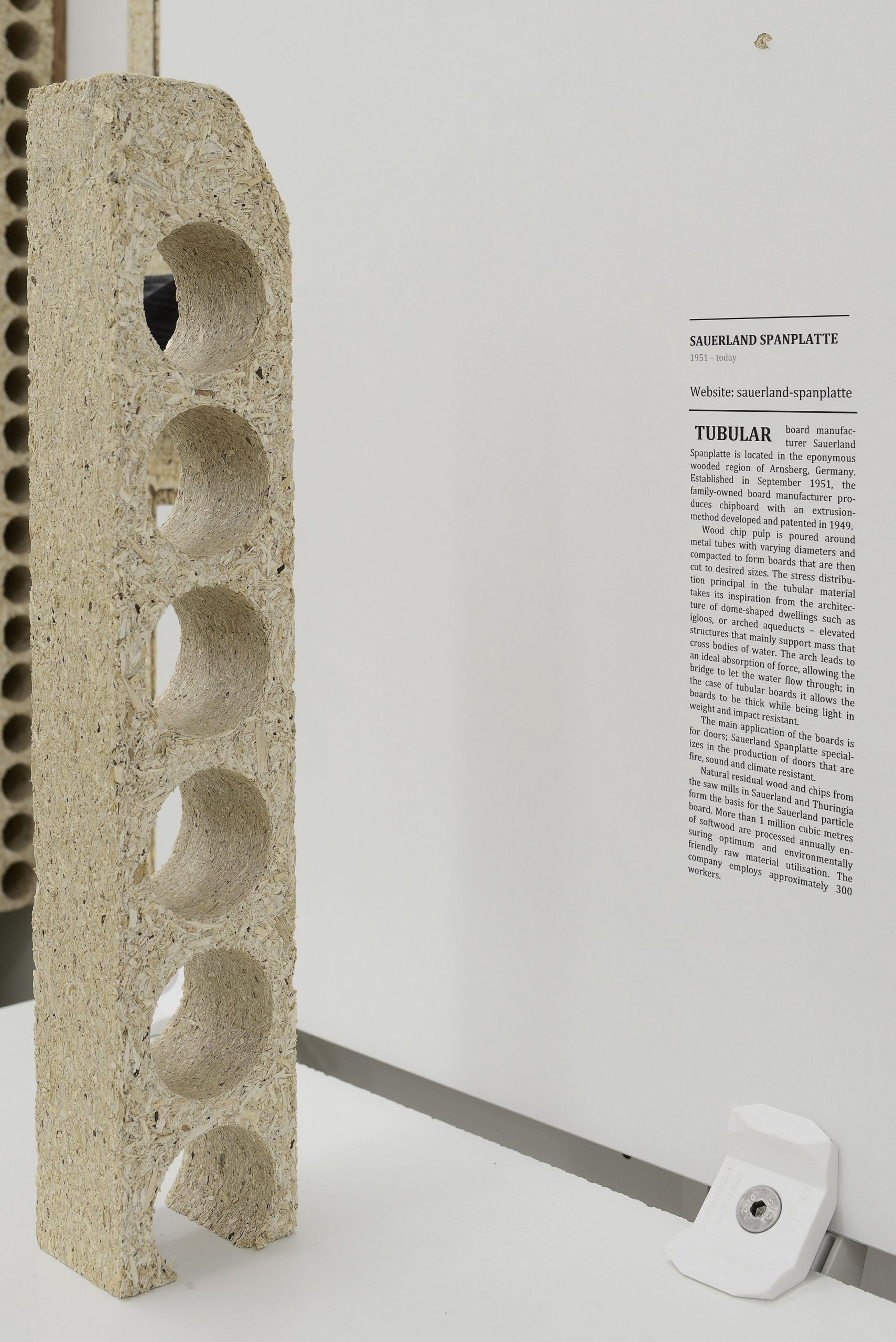
AC: The other thing as well with not only with this exhibition, but it seems like an ongoing concern in your practice is about display in general. And one of those things that is exemplifies that in the exhibition is, the idea of using elements that are synonymous with kind of cultural history museums rather than commercial galleries.
So you’ve included a lot of extended captions within the works that are kind of not ancillary to the work and not secondary to the work that are fundamentally part of that. So is that something that is new in the work or is kind of been ongoing?
JB: I guess I’ve been wrestling with this for about 20 years now actually. It started out with an exhibition I realized on Philips, the company. I made this presentation for a children’s festival where I had lengthy explanations through audio playback. I found that to be a terrible experience for these kids, you know? So it was like, what kind of didactic am I? Am I a secondhand historian, am I building actual museums? So since the beginning there’s been this relationship with display and translation. How can you bring some of a museum experience, or as you described a cultural history museum, into a contemporary arts sensibility? What I discovered with this most recent exhibition is that on a visual register I have been trying to draw from art historical movements such as Arte Povera and perhaps Constructivism – incorporating their encoded languages and then attenuating them with these texts as more of a museum convention. So I like to think of them more in terms (because it’s a very industrial history) I like to think of them in terms of trade fairs.
AC: Yeah.
JB: More like promotional displays as opposed to a neutral eye that a museum purports. And with that, I guess I’m trying to arrive at a new kind of fabric, a new experience that combines all of these things, but on more of a subliminal register.
AC: Yeah. I mean, it’s just what you said that about borrowing from languages, it seems to be that there is sort of like a comment on the history of painting as much as there is on the sort of history of sculpture in that sort of deviations from wall to floor. And I just thought, is that something that you were conscious of whilst making the work in terms of that kind of formal arrangements and the structures.
JB: I guess. So in terms of painting, I don’t have such a knowledge you know, it’s such a vast medium and in that sense it is probably the most encoded. But I think sculpture – it sounds stupid – but is perhaps more forgiving? So I feel like it’s more open to sampling because it starts to flirt with interiors and spatial design, whereas painting has historically had so much to do with deceptive plains.
image left:’The Sceptical Structures of Max’, 2019, courtesy T293
I’m not actually trying to get people to arrive at some realization which is concrete. It’s more of like an open play of relations and that’s also borrowed from the “cut-up” of William Burroughs and Brion Gysin, so it’s all about randomizing sources…
AC: And I guess that goes back to you saying about this will to borrow from already sort of coded languages as a way of using them as maybe like a form of bait to lead an audience into decoding more complex structures that are happening within the work.
There seems to be, you’re drawn to maybe making—one of the better word or term, friezes, like façades or snapshots of, um, of buildings, which they look like that on quick glance, but closer inspection unearths that kind of complexity of the work with all of its kind of fragments.
So you’re speaking before about, you used a series of newspaper coatings. And there’s another work. I forget the title right now but you pad its tonality with objects. Kind of mundane objects, like a mouthwash and Listerine.
JB: Yeah.
AC: Maybe you could speak about that work too.
JB: Ah, that’s nice you pick up on that.
So the whole set of works is called Strange Glow, which is based on 2 layers. Architectural reproduction which is then coupled with an unrelated 2nd source, which is layered on top of it as a constant. So in this experiment I think it’s kind of important to say that these are very associative relations.
In the sense of decoding, I’m not actually trying to get people to arrive at some realization, which is concrete. It’s more of like an open play of relations, a technique borrowed from the ‘cut-up’ of William Burroughs and Brion Gysin. This is about randomizing sources, you know, and that’s why I guess these things can look coherent, but then they’re actually quite illogical or irrational.
AC: Yeah, yeah. Sure.
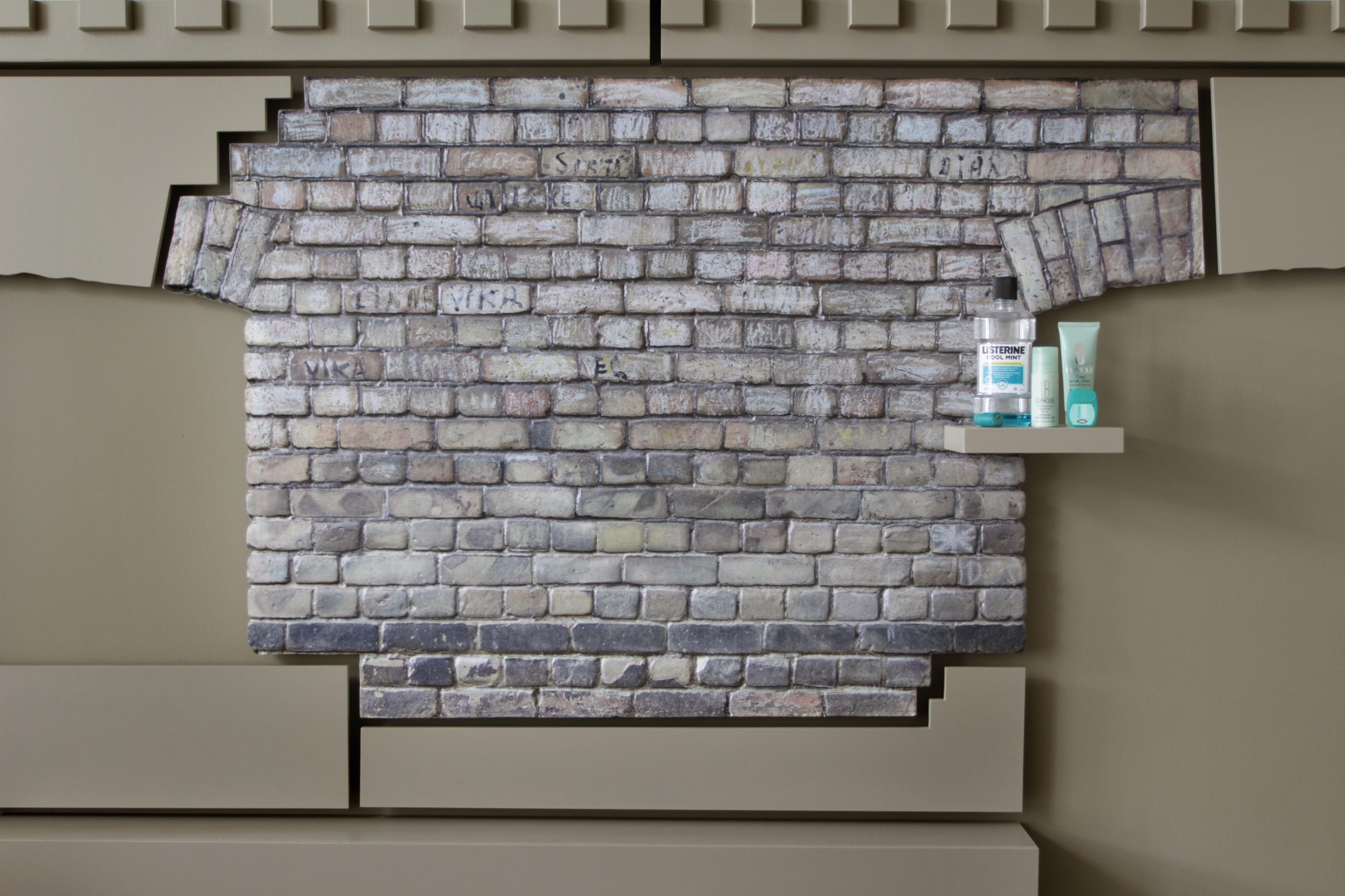
JB: So that piece that you mentioned with the background wall which is made of bricks and mouthwash–it’s to do with the mouth, right, so that’s a kind of a layer common across the whole series. It’s called Praunheim + Iranian Turquoise. The person the background is referencing is Rosa von Praunheim, a gay rights activist in Germany who was actually born in a prison in Riga. So this is in Latvia and the building is now residential. I went to that space and made a scan of the façade, then reproduced it one-on-one. The actual building is now covered with children’s chalk drawings. So if you look quite closely at that, it’s quite a human use of what was a prison, a redemption of sorts. On top of that, I then have an exercise whereby I’m trying to match the colors of Iranian turquoise (a stone often used in public fountains and mosques, as well as jewelry) with all kinds of consumer products. So you have a candle, you have mouthwash, you know, they’re all quite domestic bathroom products.
AC: Yeah.
JB: I guess the most obvious correlation between these elements is the impossibility of someone like Rosa von Praunheim to be in Tehran, you know?
AC: Going back to your deep engagement with materials. I just wondered about if we could talk a little bit about; in a practical sense about the works making, I mean…
JB: Sure.
AC: Things tendencies or fabricators that you use kind of regularly. And maybe could talk a little bit about the journey of the works making.
JB: Absolutely. Yeah. So I don’t use any fabricators for anything, I do almost everything myself. I have a studio with two occasional artist assistants, a sound artist from Portugal, André Avelãs, and a young Dutch artist called Stefan Cammeraat.

James Beckett studio view, 2015. Photo credit: Jochem Sanders
We all have very similar cultural resonances, so it feels like a small collective at times, although it’s of course also an employment thing. For these architectural reproductions and a lot of the details of the Sceptical Structures of Max, I have a CNC machine in my studio.
At times that runs like 24 hours a day, as they’re very detailed kind of prints, if you like, it’s just a subtractive process. Other productions, like the Sceptical Structures of Max are really a kind of a sampling of the streets, so it’s important to go out and fish those materials from their context. That becomes like a survey in itself, you know?
image left: PRAUNHEIM + TURQUOISE, 2019, courtesy Wilfried Lentz, Rotterdam
AC: Yeah. Just, what you said, it reminded me that, you also have a related occupation as a lecturer as well. I’m just interested because I’ve been working now; an addition to being a curator and writer, as a lecturer. I’m kind of increasingly interested in how that may or may not affect one’s practice. So you teach in Amsterdam.
JB: I teach in Arnhem in the Netherlands, usually. Are you from, are you from Manchester, Adam by chance?
AC: I’m from Chester originally.
JB: Okay, so partially Manchester, you’re just the Chester.
Yeah, no, I’m trying to, I’m trying to locate the accent. Is that the same northern belt?
AC: Yeah.
JB: Ah, okay.
AC: Part of. It’s in between Manchester and Liverpool.
JB: And is that where you teach as well?
AC: So I’m a lecturer at John Moores University in Liverpool.
JB: Oh, nice.
AC: So I lecture there among three different courses. So one of them includes Fine Arts, the other’s Art History, and another course called Exhibition Studies.
JB: Fantastic.
AC: One of them is post-graduate, and two of them are undergraduate.
JB: Fantastic. Yeah, so it’s a very rich experience, I’m sure you can agree. The connection across generations is important. Prior to tutoring I hardly had any contact with people around the age of 20 years, you know, so most of my friends are like my age and up, which is about 40.
So this for me was an important keying into a different, you know, generation somehow. I teach a bachelor’s degree in fine arts, called Base for Experiment, Art and Research. We’re one of the few art schools in the Netherlands, which follows a kind of German professorship model whereby we mix all of our years. So I have students from first, second, third, and fourth year, all in one big pot of yoghurt.
Some guy’s shouting outside. I don’t know what’s up. I don’t know if you’re hearing. He’s like “Woooooooaaaaaaaaa”
AC: I’ve got kids screaming in the background here too.
JB: I don’t hear it.
AC: …Zoom, it has noise cancellation, apparently.
JB: Child and random stranger exclusion.
Yeah, so I think the ideological space that you encounter in a university or an art school is fantastic along with the interdisciplinary nature of such spaces. We have fashion and product design in Arnhem (amongst others), so a lot of our artists are within this sort of a recognizing, “okay, so we are an industry unto our own?”
So I think there’s already this crisis, in terms of what is your cultural production, what’s your participation in terms of the world space? There’s a lot of uncertainty already within these studies, you know, and I find that that’s quite interesting. Yeah, but the values of collaborative space – I think the UK has been fantastic with integrating research and collaborative practice.
So with Goldsmiths, for example, I think it’s a much more established historical thing to the point where it’s a given, but in some schools it’s not.
AC: Yeah. Yeah, that’s true. It seems very integrated within the position, the idea of research—although that’s can be quite difficult at times to define where the research ends and where the research starts.
But I guess it’s similar to, working an occupation as an artist, that sort of endeavor where there’s no stop and start line.

‘The Sceptical Structures of Max’, 2019, courtesy T293
AC: The other thing is I want to talk about is, what you’re working on at the moment and how has the current conditions impacted your work or maybe there’s still—you need still time to kind of process that.
JB: Yeah. So I foresaw a bit the lockdown–I got quite paranoid and we actually stockpiled–as did the director of our residency here. I was also visiting an archive as I’m studying air conditioning–the building where our studios are is actually the first air-conditioned space in the world!
AC: Wow.
JB: The reason it’s attributed this title is because it was a printing house and they were trying to control the humidity as the paper was expanding and contracting, which resulted in misalignment for the printing of their CMYK – their offset printing. A young engineer who was brought in to resolve this learnt how to control dew point or humidity (Willis Carrier).
This in combination with refrigeration became the first modern air conditioning. So in terms of COVID, I connected to the archive of the company he established, called Carrier, in Syracuse, upstate New York. I was able to access and scan a couple of thousand documents. I set up a camera then I basically rummaged their archive, you know?
So you ask for a box, you get those documents and you just intuitively snap those. I have a big log that I’ve been able to work with during the first lockdown, which later became a lecture…
AC: Were you aware about this before you went to the residency? Or is it something that you found whilst you were there?
JB: Oh, whilst I was there. Yeah. They introduced the fact that it was the first air-conditioned space, but they knew little about it. And then a little bit of digging resulted in this extensive archive.
AC: That is really pertinent to your work, isn’t it? This idea of industry? Yeah. So you’re working through the archives at the moment?
JB: Yeah. So I realized a lecture, which is a kind of hopscotch through some of these documents and then trying to connect them with some of the implications, like cultural, socio-economical implications of air conditioning – one of which led me to architecture. So, just out my window here, we have the skyline of New York. I can see a Mies van der Rohe and we have this beautiful building called the Lever House. This was the first building to be hermetically sealed for the purpose of air conditioning. This building meant the birth of the ‘window washer gondola’, which is a kind of cage structure on wires, which goes on the outside of a building.
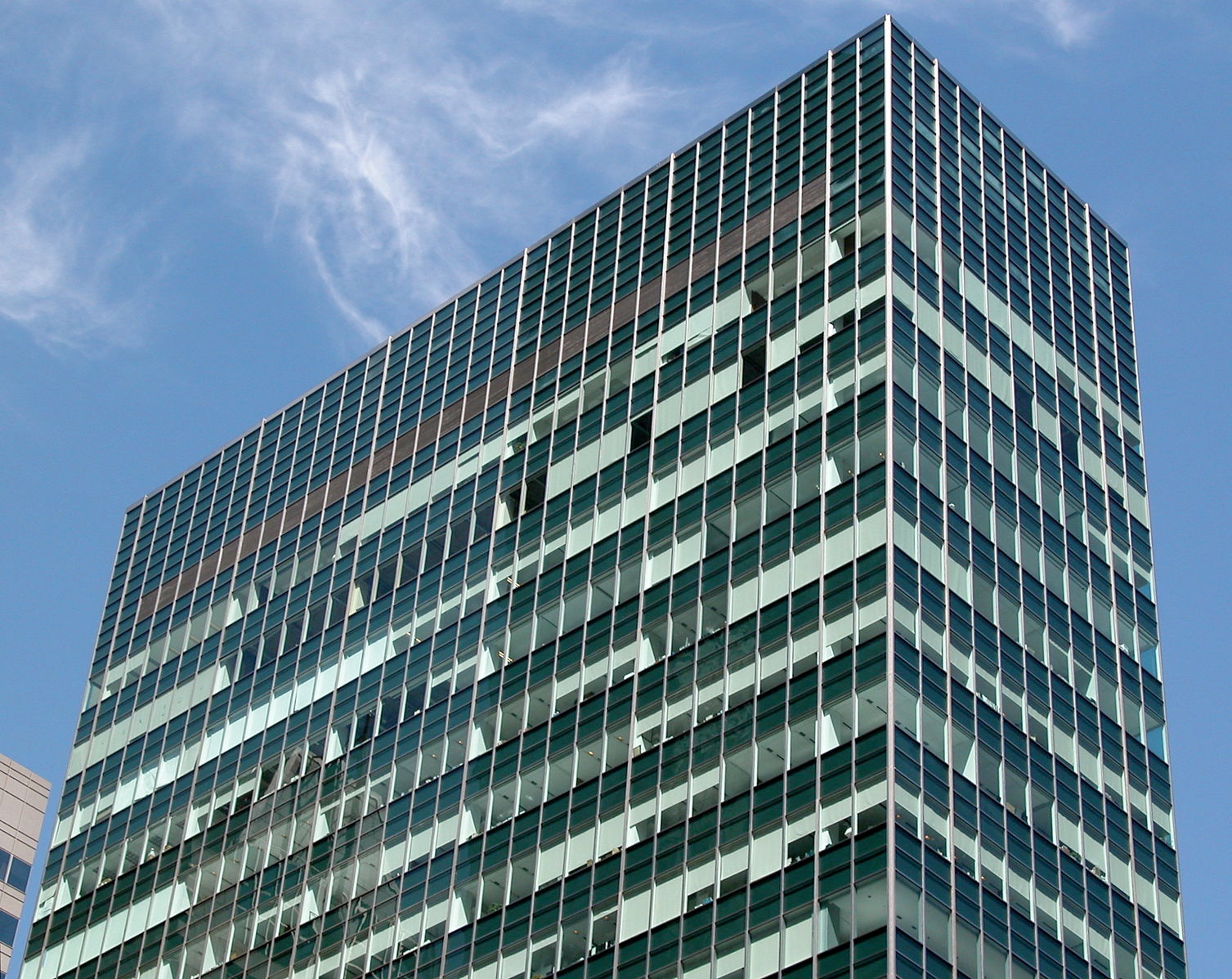
Lever House, Skidmore Owings & Merrill, photo credit Seth Tisue
They come down on this platform, but you know, prior to that, the window washer used to go directly out the window in order to clean it. They’d go through the window and then latch into these hooks. But you used to have this contact, you know, there’d be this human element.
But with the window gondola and hermetically sealed buildings for air conditioning, it meant that the window washer became this kind of perverse outsider voyeur, whereas he used to be like another member of staff. So things such as this are informing the research. Telling moments in the histories of air conditioning, as opposed to a technical overview or grand historical account.
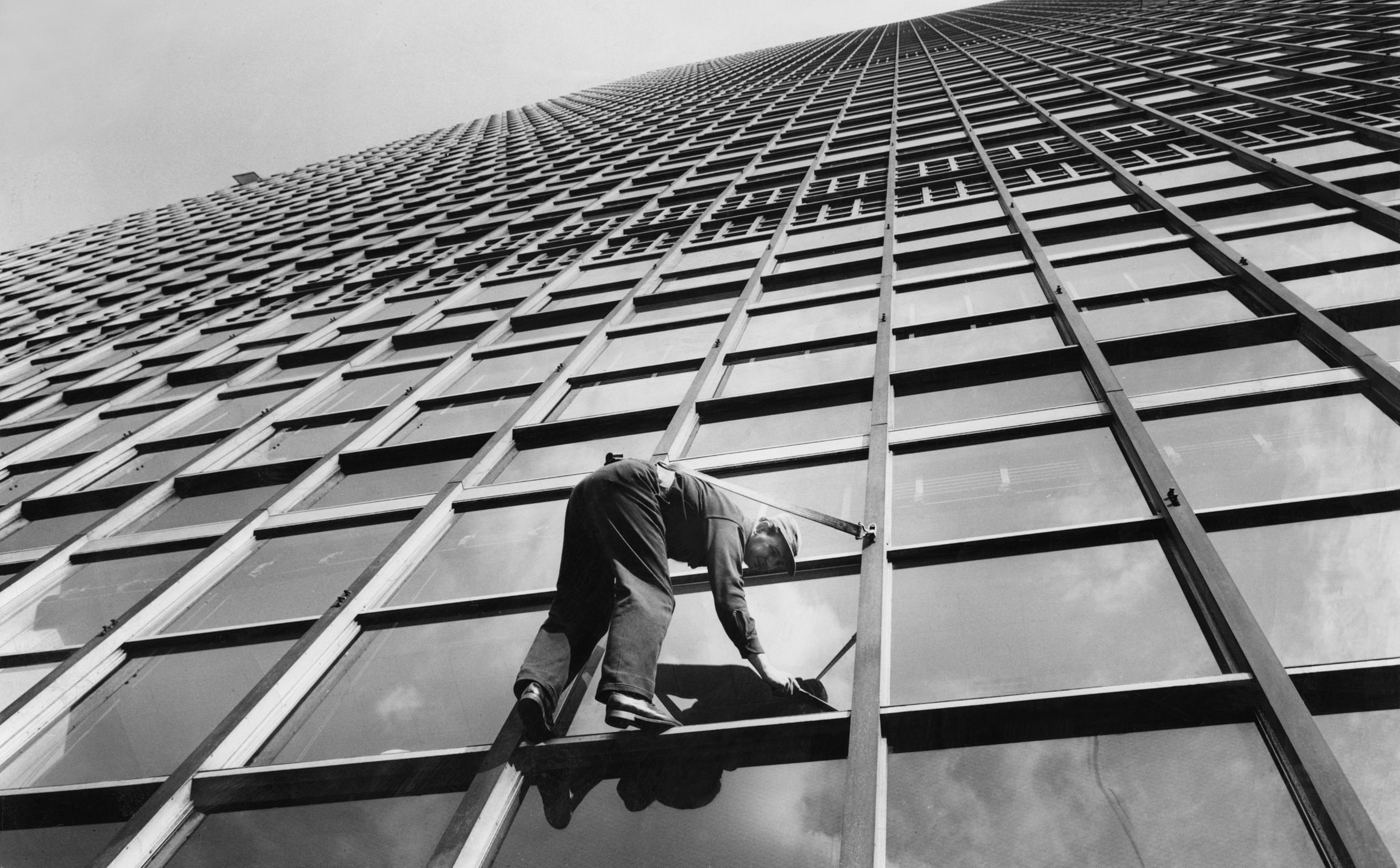
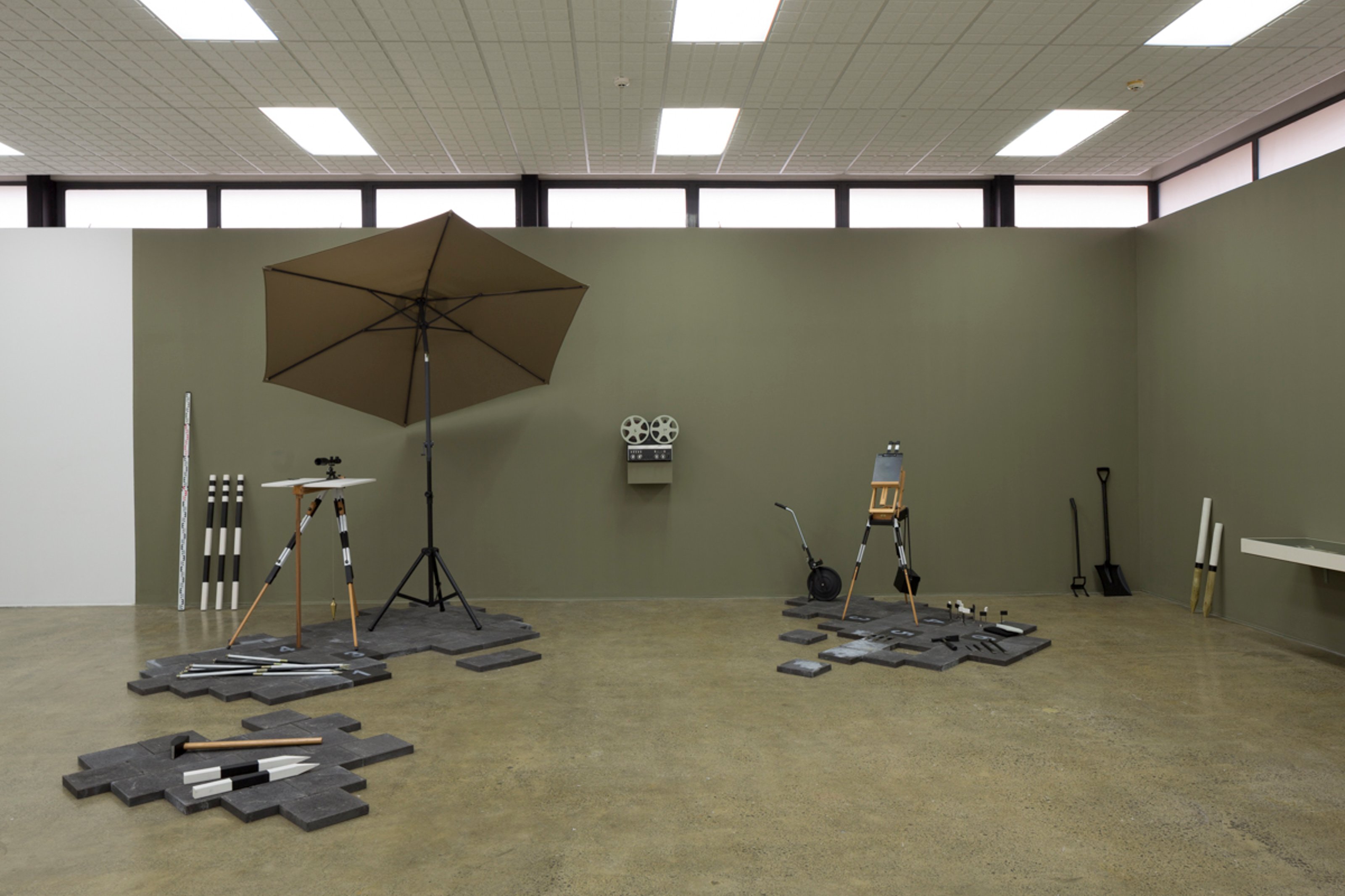
AC: The other thing I was reading about is; you did this project using dowsing, which is… I don’t know if it’s kind of like a UK centric phenomenon, if it’s…
JB: Absolutely.
AC: So the reason why I was so drawn to it and so fascinated by it is that I always enjoy, artist having kind of like a new bend or take on the idea of the immaterial and somehow dicing, dowsing fits in with this kind of history in a way.
JB: That’s nice you pick up on that because it’s a kind of a flirtation that’s constant through-out my work, like the potential of a metaphysic, but then the obvious fact that a lot of these practices are simply highly speculative things, you know? So indeed, in England, it’s very alive.
And in the Commonwealth. So in South Africa, it’s a thing. You know, like some, some grandparent would get a wine bottle and then they’d be like: ‘whaaawwwww it’s shaking, it’s shaking’. When I took this exhibition to New Zealand, they were like: ‘you don’t have to tell us about dowsing’ you know, it was really like, okay, what are you bringing as import? We brought you all the way across and… you know what I mean? It really seems to be commonplace there. But indeed these two dowsers I brought over, one was from Kent and the other was from Cornwall. I also ended up coming across Tracey Emin’s father by chance when I was interviewing UK dowsers to see whom I could bring across. So Tracey Emin’s father was one of the most helpful people in educating me into the subcultures of dowsing.
A lot of them are ex-plumbers and, you know, used to work for the government. So they actually used to use dowsing for finding breaks in water pipes, stuff like this. I brought them over to make surveys of schoolyards. So we went to around 10 different schools and scanned their playgrounds looking for former archeology.
So its quite like the ‘Strange Glow’ project. It was a compacting exercise, a bit like an absurdist play. Randomization. Like why the school ground? Why the dowser? There was something more sinister perhaps, underlying that action. The dowsers would find stuff, we’d walk two feet forward, then he’d be like, ‘oh oh oh’, so we’d put down a flag. We basically mapped out these supposed buried floor plans, you know?
They would be like, oh, this was a Roman battle or this was this etc… So yeah, I made a couple of radio programs documenting this process. If you want to listen there’s three radio programs where you can hear them talking.
AC: Yeah, I’ll go away and study the world of dowsing. Does it actually work? I mean…
JB: Well they’ve done scientific tests, you know, whereby they do hide stuff then they ask dowsers to find it, but it’s absolutely not proven, no, it doesn’t yield results. Then there’s all of these circumstantial things whereby the dowser would say, “oh, but you know, you can’t be scrutinizing the practice, otherwise it will hide itself” you know, those kinds of typical metaphysical arguments.
AC: And again, it was displayed in a way of—it had the static feeling of a cultural history museum again. It was displayed as kind of a form of artifacts.
JB: Yeah. So it’s a proposed survey kit, which I developed for dowsers. So it’s an extended series of things based on some of the pseudoscience that they use. And then there’s a collection of dowsing sticks from around the world. So there’s like Korean and Ukrainian sticks, connecting to all kinds of other subcultures, like Feng Shui for example, which is tied to fault lines and the like. These elements are very actual, you know, such as how to you align your house in terms of the Earth’s energies, things like this, so…
AC: …interweaves with different subcultures you found.
JB: Yeah, so I enjoy this kind of research, you know. It’s a kind of freedom, that you’re not accountable to subject matter or representation for accuracy within genres or so. There’s a lot of short-circuiting within my work, absurdism which I think can be off-putting for some people.
I think the work remains obscure, a characteristic that I really try and [00:30:00] preserve actually. Yeah. So that’s a bit the test is to see, can you retain complexity, whilst having a public?
image left: Dowsing Schools: Preliminary Findings and Corresponding Survey Kit, 2014
AC: Yeah. In terms of the… I was just thinking about your work and in the light of it, dealing with these kind of fatalistic people who seem to meet ends and new beginnings in the work; and one of your pieces is that you’ve done a permanent piece, which kind of contrast from this idea of something that’s maybe short lived. I mean, not in terms of the actual work and its physical sense, but the idea of your research subject matters seem to play a lot at the time at sort of temporalities. And in spite of that, you have a permanent piece somewhere, I remember reading.
JB: Actually, yeah, it’s quite a strange one. I don’t know if I have a permanent piece because there was a hospital, but due to the funding cuts in the Netherlands some hospitals have become redundant. It was an artwork I had across six floors of the Cancer Research Institute of the Netherlands.
That has recently been dissolved as a collection. Then I also have a larger piece for public space, that tours –a modular deconstructable building.
AC: Yeah. Yeah.
JB: That’s a recreation of the Dutch crystal palace. Just like the Crystal Palace, the Dutch had what was called the ‘Paleis voor Volksvlijt’, or the people’s palace, and this burnt down. There was also the one in Munich – the ‘Glaspalast’ which also burnt down. So my piece ‘Palace Ruin’ was about the symbolism of such architecture in creating communities or showcasing culture and industry and the connecting of countries and when that comes to an end. I took this piece to Latvia and to China, but it originated in Amsterdam. I guess it’s also quite temporal – it’s not a permanent piece. We host talks on architecture, urban planning, ruin, – it’s a kind of stage for a reflection on the built environment.

‘Palace Ruin’, 2016. Photo credit: Andrejs Strokins. Courtesy of James Beckett and the Riga International Biennial of Contemporary Art
AC: Right. That’s a great place to end I think, I’m conscious that one of my sons is about to play piano.
And there’s nothing I can do to stop him. So in about five minutes time, we’ll have lots of…
JB: Tchaikovsky.
AC: …piano noises, yeah.
JB: Nice.
AC: But thank you so much, James.
JB: Yeah. Thanks for the time. And the investment in looking through my work, that’s a real privilege.
AC: Yeah. No, my pleasure. Yeah. I’ve been following your work at a distance for many, many years. So it’s great that it’s met the kind of opportunity and my research on your work because you’ve been on my radar now, as I said, for many, many years. I remember seeing your work at the Venice Biennale with the robot arm with the houses. Maybe just quickly, if you could say some words, because that is quite interesting in terms of — there’s a bit of a biographical link as well.
JB: Yeah. That piece is a kind of futuristic urban planning device which looks at real cases of African modernist architecture, so like airports, universities – quite ‘display’ orientated architecture from post-colonial times, or like, you know, between 1945 and 1967, this period.

‘Negative Space: A Scenario Generator for Clandestine Building in Africa’, 2015. Courtesy of James Beckett, Wilfried Lentz, T293.
After the war (WWII) and the beginning of the independence movements of African countries. What the device does is, it takes these building blocks, which represent all the negative spaces of these buildings and it lays them out to create a portrait of each of those buildings, according to this negative space. This is a suggestion for what’s known as “clandestine building.”
That’s when one uses residual space for living, or the illegal expansion of ones living space. Most typically it’s the bricking in of balconies to create extra space. What if you have like a portico or colonnade of an airport, such as the entrance hall? It’s basically suggesting to brick in all of these cavities so there’s more living space – completely impractical and quite anarchistic of course.
AC: Yeah. Great. Thank you again, James.
JB: Yeah. You’re welcome.
End.